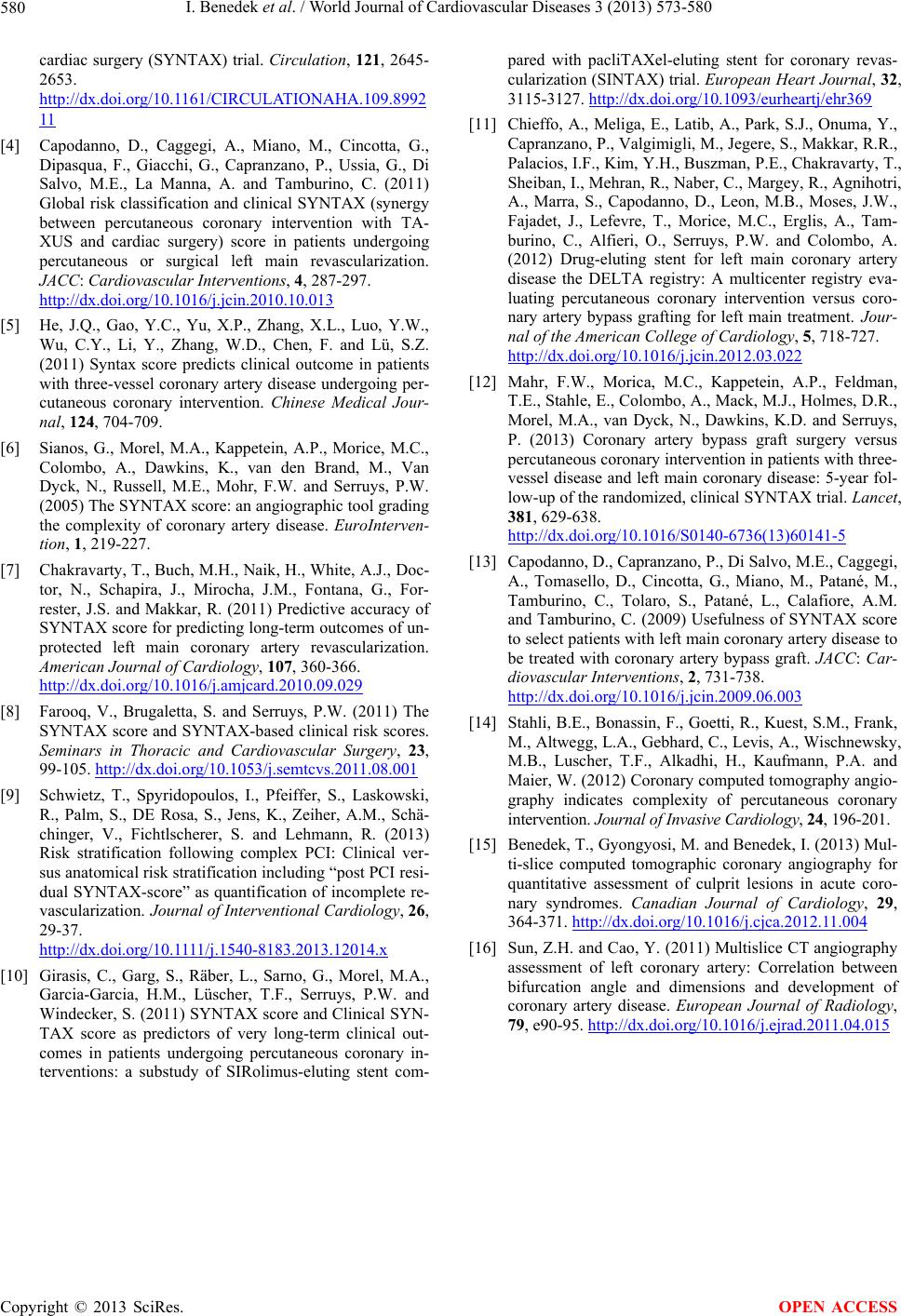
I. Benedek et al. / World Journal of Cardiovascular Diseases 3 (2013) 573-580
Copyright © 2013 SciRes.
580
OPEN ACCESS
cardiac surgery (SYNTAX) trial. Circulation, 121, 2645-
2653.
http://dx.doi.org/10.1161/CIRCULATIONAHA.109.8992
11
[4] Capodanno, D., Caggegi, A., Miano, M., Cincotta, G.,
Dipasqua, F., Giacchi, G., Capranzano, P., Ussia, G., Di
Salvo, M.E., La Manna, A. and Tamburino, C. (2011)
Global risk classification and clinical SYNTAX (synergy
between percutaneous coronary intervention with TA-
XUS and cardiac surgery) score in patients undergoing
percutaneous or surgical left main revascularization.
JACC: Cardiovascular Interventions, 4, 287-297.
http://dx.doi.org/10.1016/j.jcin.2010.10.013
[5] He, J.Q., Gao, Y.C., Yu, X.P., Zhang, X.L., Luo, Y.W.,
Wu, C.Y., Li, Y., Zhang, W.D., Chen, F. and Lü, S.Z.
(2011) Syntax score predicts clinical outcome in patients
with three-vessel coronary artery disease undergoing per-
cutaneous coronary intervention. Chinese Medical Jour-
nal, 124, 704-709.
[6] Sianos, G., Morel, M.A., Kappetein, A.P., Morice, M.C.,
Colombo, A., Dawkins, K., van den Brand, M., Van
Dyck, N., Russell, M.E., Mohr, F.W. and Serruys, P.W.
(2005) The SYNTAX score: an angiographic tool grading
the complexity of coronary artery disease. EuroInterven-
tion, 1, 219-227.
[7] Chakravarty, T., Buch, M.H., Naik, H., White, A.J., Doc-
tor, N., Schapira, J., Mirocha, J.M., Fontana, G., For-
rester, J.S. and Makkar, R. (2011) Predictive accuracy of
SYNTAX score for predicting long-term outcomes of un-
protected left main coronary artery revascularization.
American Journal of Cardiology, 107, 360-366.
http://dx.doi.org/10.1016/j.amjcard.2010.09.029
[8] Farooq, V., Brugaletta, S. and Serruys, P.W. (2011) The
SYNTAX score and SYNTAX-based clinical risk scores.
Seminars in Thoracic and Cardiovascular Surgery, 23,
99-105. http://dx.doi.org/10.1053/j.semtcvs.2011.08.001
[9] Schwietz, T., Spyridopoulos, I., Pfeiffer, S., Laskowski,
R., Palm, S., DE Rosa, S., Jens, K., Zeiher, A.M., Schä-
chinger, V., Fichtlscherer, S. and Lehmann, R. (2013)
Risk stratification following complex PCI: Clinical ver-
sus anatomical risk stratification including “post PCI resi-
dual SYNTAX-score” as quantification of incomplete re-
vascularization. Journal of Interventional Cardiology, 26,
29-37.
http://dx.doi.org/10.1111/j.1540-8183.2013.12014.x
[10] Girasis, C., Garg, S., Räber, L., Sarno, G., Morel, M.A.,
Garcia-Garcia, H.M., Lüscher, T.F., Serruys, P.W. and
Windecker, S. (2011) SYNTAX score and Clinical SYN-
TAX score as predictors of very long-term clinical out-
comes in patients undergoing percutaneous coronary in-
terventions: a substudy of SIRolimus-eluting stent com-
pared with pacliTAXel-eluting stent for coronary revas-
cularization (SINTAX) trial. European Heart Journal, 32,
3115-3127. http://dx.doi.org/10.1093/eurheartj/ehr369
[11] Chieffo, A., Meliga, E., Latib, A., Park, S.J., Onuma, Y.,
Capranzano, P., Valgimigli, M., Jegere, S., Makkar, R.R.,
Palacios, I.F., Kim, Y.H., Buszman, P.E., Chakravarty, T.,
Sheiban, I., Mehran, R., Naber, C., Margey, R., Agnihotri,
A., Marra, S., Capodanno, D., Leon, M.B., Moses, J.W.,
Fajadet, J., Lefevre, T., Morice, M.C., Erglis, A., Tam-
burino, C., Alfieri, O., Serruys, P.W. and Colombo, A.
(2012) Drug-eluting stent for left main coronary artery
disease the DELTA registry: A multicenter registry eva-
luating percutaneous coronary intervention versus coro-
nary artery bypass grafting for left main treatment. Jour-
nal of the American College of Cardiology, 5, 718-727.
http://dx.doi.org/10.1016/j.jcin.2012.03.022
[12] Mahr, F.W., Morica, M.C., Kappetein, A.P., Feldman,
T.E., Stahle, E., Colombo, A., Mack, M.J., Holmes, D.R.,
Morel, M.A., van Dyck, N., Dawkins, K.D. and Serruys,
P. (2013) Coronary artery bypass graft surgery versus
percutaneous coronary intervention in patients with three-
vessel disease and left main coronary disease: 5-year fol-
low-up of the randomized, clinical SYNTAX trial. Lancet,
381, 629-638.
http://dx.doi.org/10.1016/S0140-6736(13)60141-5
[13] Capodanno, D., Capranzano, P., Di Salvo, M.E., Caggegi,
A., Tomasello, D., Cincotta, G., Miano, M., Patané, M.,
Tamburino, C., Tolaro, S., Patané, L., Calafiore, A.M.
and Tamburino, C. (2009) Usefulness of SYNTAX score
to select patients with left main coronary artery disease to
be treated with coronary artery bypass graft. JACC: Car-
diovascular Interventions, 2, 731-738.
http://dx.doi.org/10.1016/j.jcin.2009.06.003
[14] Stahli, B.E., Bonassin, F., Goetti, R., Kuest, S.M., Frank,
M., Altwegg, L.A., Gebhard, C., Levis, A., Wischnewsky,
M.B., Luscher, T.F., Alkadhi, H., Kaufmann, P.A. and
Maier, W. (2012) Coronary computed tomography angio-
graphy indicates complexity of percutaneous coronary
intervention. Journal of Invasive Cardiology, 24, 196-201.
[15] Benedek, T., Gyongyosi, M. and Benedek, I. (2013) Mul-
ti-slice computed tomographic coronary angiography for
quantitative assessment of culprit lesions in acute coro-
nary syndromes. Canadian Journal of Cardiology, 29,
364-371. http://dx.doi.org/10.1016/j.cjca.2012.11.004
[16] Sun, Z.H. and Cao, Y. (2011) Multislice CT angiography
assessment of left coronary artery: Correlation between
bifurcation angle and dimensions and development of
coronary artery disease. European Journal of Radiology,
79, e90-95. http://dx.doi.org/10.1016/j.ejrad.2011.04.015